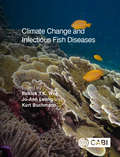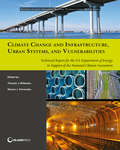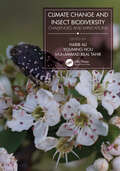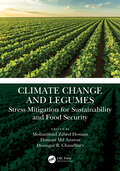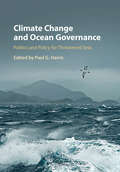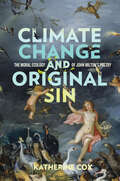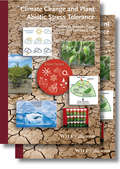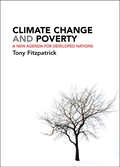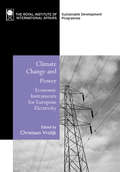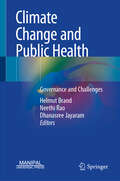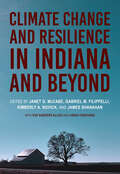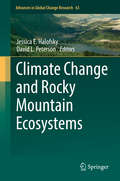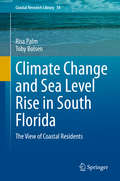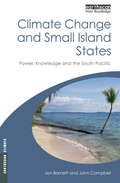- Table View
- List View
Climate Change and Individual Responsibility: Agency, Moral Disengagement and the Motivational Gap
by Sigrid Sterckx Wouter Peeters Andries De Smet Lisa DiependaeleThis book discusses the agency and responsibility of individuals in climate change, and argues that these are underemphasized, enabling individuals to maintain their consumptive lifestyles without having to accept moral responsibility for their luxury emissions.
Climate Change and Infectious Fish Diseases
by Patrick T.K. Woo Jo-Ann Leong Kurt BuchmannClimate change with global warming is not disputed by the vast majority of scientists and the aquatic system is most affected. A global rise in water temperature and acidification of the aquatic environment will continue even if we can significantly reduce the current output of the two most important greenhouse gasses (carbon dioxide and methane). These and other environmental changes will affect fish health which includes infectious pathogens. This important new text is the second volume on climate change and fish health. It covers changes to the freshwater ecosystem and their current and expected effects on selected infectious diseases of fish. The book represents contributions by over 50 experts from 18 countries. Comprehensive and thought-provoking, the book details abiotic and biotic environmental changes in temperate and tropical freshwater ecosystems, sequestrations of atmospheric carbon dioxide and effects on infectious diseases (12 microbial and 10 parasitic) in economically important fish in tropical, subtropical and temperate waters. The text is key reading for fish disease scientists, aquatic ecologists, fish health consultants, veterinarians, policy makers and all who are interested in fish health and the environment.
Climate Change and Infrastructure, Urban Systems, and Vulnerabilities: Technical Report for the U.S. Department of Energy in Support of the National Climate Assessment (NCA Regional Input Reports)
by Thomas J. Wilbanks Steven FernandezHurricane Irene ruptured a Baltimore sewer main, resulting in 100 million gallons of raw sewage flooding the local watershed. Levee failures during Hurricane Katrina resulted in massive flooding which did not recede for months. With temperatures becoming more extreme, and storms increasing in magnitude, American infrastructure and risk-management policies require close examination in order to decrease the damage wrought by natural disasters. Climate Change and Infrastructure, Urban Systems, and Vulnerabilities addresses these needs by examining how climate change affects urban buildings and communities, and determining which regions are the most vulnerable to environmental disaster. It looks at key elements of urban systems, including transportation, communication, drainage, and energy, in order to better understand the damages caused by climate change and extreme weather. How can urban systems become more resilient? How can citizens protect their cities from damage, and more easily rebound from destructive storms? This report not only breaks new ground as a component of climate change vulnerability and impact assessments but also highlights critical research gaps in the material. Implications of climate change are examined by assessing historical experience as well as simulating future conditions. Developed to inform the 3rd National Climate Assessment, and a landmark study in terms of its breadth and depth of coverage and conducted under the auspices of the U. S. Department of Energy, Climate Change and Infrastructure, Urban Systems, and Vulnerabilities examines the known effects and relationships of climate change variables on American infrastructure and risk-management policies. Its rich science and case studies will enable policymakers, urban planners, and stakeholders to develop a long-term, self-sustained assessment capacity and more effective risk-management strategies.
Climate Change and Insect Biodiversity: Challenges and Implications
by Muhammad Bilal Tahir Habib Ali Youming HouThis up-to-date reference book discusses the effects of climate change on the biodiversity of insect pests. The changing climate and agricultural intensification practices impact negatively on insect biodiversity. The book explains the significance of insect pests for evaluating climatic impacts on a wide range of ecological systems. It covers the effect of climate change on pollinators and household and agricultural insect pests. It explains how climate-smart agriculture can enhance productivity and food security.FEATURES Reviews the effects of climate change on plant-insect interactions Includes topics such as insect biodiversity informatics and conservation Discusses food security, pest management, and beneficial and social insects Covers topics such as precision agriculture and climate-smart agriculture Provides insights on the relation between agriculture intensification and insect biodiversity This book is meant for scientists, researchers, and students working in the fields of agriculture, entomology, ecology, plant science, environmental biology, and biotechnology.
Climate Change and Insurance: Disaster Risk Financing in Developing Countries
by Eugene N. GurenkoClimate change brings about a new set of major economic risks arising from changing weather patterns, extreme weather events and rising sea levels. Most at risk are developing countries who, despite considerable post-disaster donor aid, have been bearing the major brunt of disaster-related losses. One adaptation solution that is rapidly gaining the support of countries and international donors is a risk transfer to the global reinsurance and capital markets. This volume, a special issue of the journal Climate Policy, explores the role that insurance-based mechanisms can play in helping developing countries prepare for climate change. It offers a unique and comprehensive perspective on the potential role of insurance solutions in global adaptation to climate change and attempts to engender debate on the role of insurance in reducing global emissions and encouraging climate-friendly corporate behaviour.
Climate Change and Its Impacts: Risks and Inequalities (Climate Change Management)
by Colleen Murphy Paolo Gardoni Robert McKimResponding to a need for a deeper and more nuanced understanding of the consequences of climate change, this book brings experts in climate science, engineering, urban planning, and conservation biology into conversation with scholars in law, geography, anthropology and ethics. It provides insights into how climate change is conceptualized in different fields. The book also aims to contribute to developing successful and multifaceted strategies that promote global, intergenerational and environmental justice. Among the topics addressed are the effects of climate change on the likelihood and magnitude of natural hazards, an assessment of civil infrastructure vulnerabilities, resilience assessment for coastal communities, an ethical framework to evaluate behavior that contributes to climate change, as well as policies and cultural shifts that might help humanity to respond adequately to climate change.
Climate Change and Justice
by Jeremy MossAchieving climate justice is increasingly recognized as one of the key problems associated with climate change, helping us to determine how good or bad the effects of climate change are, and whether any harms are fairly distributed. The numerous and complex issues which climate change involves underline the need for a normative framework that allows us both to assess the dangers that we face and to create a just distribution of the costs of action. This collection of original essays by leading scholars sheds new light on the key problems of climate justice, offering innovative treatments of a range of issues including international environmental institutions, geoengineering, carbon budgets, and the impact on future generations. It will be a valuable resource for researchers and upper-level students of ethics, environmental studies, and political philosophy.
Climate Change and Legumes: Stress Mitigation for Sustainability and Food Security
by Doongar R. Chaudhary Hossain Anawar Mohammad Zabed HossainGlobal climate change has created unprecedented challenges for human civilization due to its widespread adverse consequences, including a reduction in crop yield and threatening food security across the globe. Among the crop plants, legumes have great potential for ameliorating global warming since they can reduce carbon emissions by lowering reliance on the application of chemical fertilizers, by increasing nitrification and carbon sequestration in soil, and by providing protein-rich diets to both humans and livestock. This book identifies the extent of climate-induced stresses on legume plants and focuses on achieving food security through sustainable agricultural practices.This book compiles recent research findings and reviews on climate-related problems, the potential of legumes in ameliorating the impacts of climate change, as well as better management of agricultural land and practices for achieving environmental sustainability and food security.This book will serve as guidelines for scientists, agricultural practitioners, and policymakers working to achieve food security and better management of climate-induced stresses in agricultural interventions. It will also be useful as a reference book for researchers and students of both graduate and postgraduate levels. Furthermore, this book will provide enhanced knowledge about the mechanisms of yield and stress tolerance of legumes as well as developing climate-smart crops and improving cropping systems for a sustainable environment and food security. Features of the book Reviews trends of global climate change and its consequences for food security across the continents Identifies the challenges and scopes of cultivating legumes in achieving food security in the context of global climate change Focuses on the improvements of legume production through conservation approaches in agricultural practices and modern techniques, including omics-based breeding, biotechnology, genetic engineering, and rhizobium technology Discusses the sustainable amelioration options for soils affected by climate-induced stresses Cites examples of applications of rhizobium technologies in reducing greenhouse gas emission Describes pathways associated with yield, resistance, and tolerance of legumes to climate-induced stresses
Climate Change and Management of Cool Season Grain Legume Crops
by Shyam Singh Yadav Robert Redden David L. Mcneil Sharanagouda A. PatilThis book covers all aspect of legume production management technologies, plant ecological response, nutrients management, biological nitrogen fixation, molecular approaches, potential cultivars, biodiversity management under climate change. Also covered are various aspects of legume management under climate change such as, production management technology, ecology & adaptation, diseases, and international trade; physiology and crops response to nutrients, drought, salinity, and water use efficiency; Biodiversity management, molecular approaches and biological Nitrogen fixation; climate change and strategies. This book presents the most comprehensive and up to date review of research on different cool season grain legume crops, nutrients management, biotic and abiotic stresses management, agronomical approaches for drought management, salinity, drought, weed management and water use efficiency, impact on international trade around the world.
Climate Change and Multi-Dimensional Sustainability in African Agriculture: Climate Change and Sustainability in Agriculture
by Rattan Lal Bal Ram Singh David Kraybill David O. Hansen Lars Olav Eik Theodosy MosogoyaThis 35-chapter book is based on several oral and poster presentations including both invited and contributory chapters. The book is thematically based on four pillars of sustainability, with focus on sub-Saharan Africa (SSA): Environment, Economic, Social and Institutional. The environmental sustainability, which determines economic and social/institutional sustainability, refers to the rate of use of natural resources (soil, water, landscape, vegetation) which can be continued indefinitely without degrading their quality, productivity and ecosystem services for different ecoregions of SSA. This book will help achieve the Sustainable Development Goals of the U. N. in SSA. Therefore, the book is of interest to agriculturalists, economists, social scientists, policy makers, extension agents, and development/bilateral organizations. Basic principles explained in the book can be pertinent to all development organizations.
Climate Change and Ocean Governance: Politics and Policy for Threatened Seas
by Paul G. HarrisClimate Change and Ocean Governance brings together authors from political science and cognate disciplines to examine the political and policy dimensions of climate change for our oceans. The environmental, social and economic consequences of oceanic change present tremendous challenges for governments and other actors. New and innovative policies for governing oceans and seas - and for managing vital marine resources - have never been more important. Existing national and international institutions for marine governance that were created when oceanic conditions were relatively static may not be adequate for a future characterized by continuous oceanic change. Responses to oceanic change will result in winners and losers, and thus will involve politics in all its manifestations. This book reveals the unavoidable connections between climate change, the oceans, and questions of governance. It provides valuable lessons for researchers, policymakers and activists concerned about governing oceanic change into the future.
Climate Change and Order
by Beth Edmondson Stuart LevyBeth Edmondson and Stuart Levy examine why it is so difficult for the international community to respond to global climate change. In doing so, they analyse and explain some of the strategies that might ultimately provide the foundations for appropriate responses.
Climate Change and Original Sin: The Moral Ecology of John Milton's Poetry (Under the Sign of Nature)
by Katherine CoxPrior to the Enlightenment era, how was the human-climate relationship conceived? Focusing on the most recent epoch in which belief in an animate environment still widely prevailed, Climate Change and Original Sin argues that an ecologically inflected moral system assumed that humanity bore responsibility for climate corruption and volatility.The environmental problem initiated by original sin is not only that humans alienated themselves from nature but also that satanic powers invaded the world and corrupted its elements—particularly the air. Milton shared with contemporaries the widespread view that storms and earthquakes represented the work of fearsome spiritual agents licensed to inflict misery on humans as penalty for sin. Katherine Cox’s work discerns in Paradise Lost an ecological fall distinct from, yet concurrent with, the human fall. In examining Milton’s evolving representations of the climate, this book also traces the gradual development of ideas about the atmosphere during the seventeenth century—a change in the intellectual climate driven by experimental activity and heralding an ecologically devastating shift in Western attitudes toward the air.
Climate Change and Plant Abiotic Stress Tolerance
by Narendra Tuteja Sarvajeet S. GillIn this ready reference, a global team of experts comprehensively cover molecular and cell biology-based approaches to the impact of increasing global temperatures on crop productivity. The work is divided into four parts. Following an introduction to the general challenges for agriculture around the globe due to climate change, part two discusses how the resulting increase of abiotic stress factors can be dealt with. The third part then outlines the different strategies and approaches to address the challenge of climate change, and the whole is rounded off by a number of specific examples of improvements to crop productivity. With its forward-looking focus on solutions, this book is an indispensable help for the agro-industry, policy makers and academia.
Climate Change and Policy: The Calculability of Climate Change and the Challenge of Uncertainty
by Gabriele Gramelsberger Johann FeichterThe debate on how mankind should respond to climate change is diverse, as the appropriate strategy depends on global as well as local circumstances. As scientists are denied the possibility of conducting experiments with the real climate, only climate models can give insights into man-induced climate change, by experimenting with digital climates under varying conditions and by extrapolating past and future states into the future. But the 'nature' of models is a purely representational one. A model is good if it is believed to represent the relevant processes of a natural system well. However, a model and its results, in particular in the case of climate models which interconnect countless hypotheses, is only to some extent testable, although an advanced infrastructure of evaluation strategies has been developed involving strategies of model intercomparison, ensemble prognoses, uncertainty metrics on the system and component levels. The complexity of climate models goes hand in hand with uncertainties, but uncertainty is in conflict with socio-political expectations. However, certain predictions belong to the realm of desires and ideals rather than to applied science. Today's attempt to define and classify uncertainty in terms of likelihood and confidence reflect this awareness of uncertainty as an integral part of human knowledge, in particular on knowledge about possible future developments. The contributions in this book give a first hand insight into scientific strategies in dealing with uncertainty by using simulation models and into social, political and economical requirements in future projections on climate change. Do these strategies and requirements meet each other or fail? The debate on how mankind should respond to climate change is diverse, as the appropriate strategy depends on global as well as local circumstances. As scientists are denied the possibility of conducting experiments with the real climate, only climate models can give insights into man-induced climate change, by experimenting with digital climates under varying conditions and by extrapolating past and future states into the future. But the 'nature' of models is a purely representational one. A model is good if it is believed to represent the relevant processes of a natural system well. However, a model and its results, in particular in the case of climate models which interconnect countless hypotheses, is only to some extent testable, although an advanced infrastructure of evaluation strategies has been developed involving strategies of model intercomparison, ensemble prognoses, uncertainty metrics on the system and component levels. The complexity of climate models goes hand in hand with uncertainties, but uncertainty is in conflict with socio-political expectations. However, certain predictions belong to the realm of desires and ideals rather than to applied science. Today's attempt to define and classify uncertainty in terms of likelihood and confidence reflect this awareness of uncertainty as an integral part of human knowledge, in particular on knowledge about possible future developments. The contributions in this book give a first hand insight into scientific strategies in dealing with uncertainty by using simulation models and into social, political and economical requirements in future projections on climate change. Do these strategies and requirements meet each other or fail? Gabriele Gramelsberger is Principal Investigator of the Collaborative Research Project is Principal Investigator of the Collaborative Research Project
Climate Change and Post-Political Communication: Media, Emotion and Environmental Advocacy (Routledge Studies in Environmental Communication and Media)
by Philip HammondFor many years, the objective of environmental campaigners was to push climate change on to the agenda of political leaders and to encourage media attention to the issue. By the first decade of the twenty-first century, it appeared that their efforts had been spectacularly successful. Yet just at the moment when the campaigners’ goals were being achieved, it seemed that the idea of getting the issue into mainstream discussion had been mistaken all along; that the consensus-building approach produced little or no meaningful action. That is the problem of climate change as a ‘post-political’ issue, which is the subject of this book. Examining how climate change is communicated in politics, news media and celebrity culture, Climate Change and Post-Political Communication explores how the issue has been taken up by elites as potentially offering a sense of purpose or mission in the absence of political visions of the future, and considers the ways in which it provides a focus for much broader anxieties about a loss of modernist political agency and meaning. Drawing on a wide range of literature and case studies, and taking a critical and contextual approach to the analysis of climate change communication, this book will be a valuable resource for students and scholars of environmental studies, communication studies, and media and film studies.
Climate Change and Poverty: A New Agenda for Developed Nations
by Tony FitzpatrickAvailable Open Access under CC-BY-NC licence. Climate change is the main challenge facing developed countries in the 21st century. To what extent does this agenda converge with issues of poverty and social exclusion? Climate change and poverty offers a timely new perspective on the ‘ecosocial’ understanding of the causes and symptoms of, and solutions to, poverty and applies this to recent developments across a number of areas, including fuel poverty, food poverty, housing, transport and air pollution. Unlike any other publication, the book therefore establishes a new agenda for both environmental and social policies which has cross-national relevance. It will appeal to students in social policy, public policy, applied social studies and politics and will also be of interest to those studying international development, economics and geography
Climate Change and Power: Economic Instruments for European Electricity (Energy And Environmental Programme Ser.)
by Christiaan Vrolijk'This book provides an essential guide to the challenges facing the power sector, but is equally enlightening to other industrial emitters, policy-makers and non-governmental organizations.' Charles Nicholson, Group Senior Advisor, BP The electricity industry is one of the main contributors of carbon to the atmosphere. Reducing these emissions is critical to achieving international targets and mitigating climate change. Economic instruments, including emissions trading, taxes and voluntary agreements, will be crucial. However, across Europe there are widely different electricity systems and policies will have different effects. This book describes the characteristics of the main European electricity regimes, defining the range of instruments available and assessing the potential of each in each regime and for Europe as a whole.
Climate Change and Public Health: Governance and Challenges
by Dhanasree Jayaram Helmut Brand Neethi RaoThis book provides an overview of the correlation between climate change and public health, closely aligned with the UN’s Sustainable Development Goals 3 (SDG-3). It not only discusses the impacts of climate change on health but also explores how the health sector influences climate change, creating intersections between health, climate policies, and geopolitics from both global and Indian perspectives. Additionally, it covers topics such as air pollution, heat health, climate finance, and water security. From geopolitical implications to physiological impacts, it addresses the challenges posed by climate change on healthcare systems worldwide. The book is supplemented with methodologies for understanding the relationship between climate change and health, as well as designing policies to address climate and health governance. The book is relevant for academics, policymakers, geopoliticians, climate activists, and practitioners alike, providing insights into governance, air pollution, coastal ecosystems, and cultural heritage in shaping an understanding of a sustainable future.
Climate Change and Renewable Energy: How to End the Climate Crisis
by Martin J. BushThis book presents a comprehensive overview of the global climate change impacts caused by the continued use of fossil fuels, which results in enormous damage to the global environment, biodiversity, and human health. It argues that the key to a transition to a low carbon future is the rapid and large-scale deployment of renewable energy technologies in power generation, transport and industry, coupled with super energy-efficient building design and construction. However, the author also reveals how major oil companies and petrochemical conglomerates have systematically attempted to manufacture doubt and uncertainty about global warming and climate change, continue to block the commercialization of solar energy and wind power, and impede the electrification of the transport sector. Martin Bush’s solution is a theory-of-change approach to substantially reduce greenhouse-gas emissions by 2050, which sets out realistic steps that people can take now to help make a difference.
Climate Change and Resilience in Indiana and Beyond
by Richard Phillips James Shanahan Geoffrey Brown David M. Konisky Daniel Becker Ellen D. Ketterson Sanya Carley James Robert Farmer Rebecca Lave Keith Clay Paul Staten Eric Sandweiss Elizabeth Grennan Browning Jeffrey S. Dukes Melissa Widhalm Janet G. McCabe Gabriel M. Filippelli Kimberly A. Novick Ben Kravitz Douglas Edmonds Chanh Kieu Travis A. O'Brien Scott Robeson Brian Yanites Chen Zhu Sarah Mincey John Baeten Justin Maxwell Allison Byrd Adam Fudickar Matthew Houser Alex Jahn Jennifer Ann Lau Sarah Wanamaker Heather L. Reynolds Samantha L. Hamlin Dana Habeeb Jeffrey S. Wilson Daniel Myers Beth Edwards Nathan Geiger Andrea Webster Nikolaos Zirogiannis Eva Sanders Allen Lingxi ChenyangClimate change is affecting Indiana's environment, threatening the way Hoosiers live and do business, and introducing new stresses to the state's economy, health, and infrastructure. And while scientists predict more days of extreme weather, increased public health risks, and reduced agricultural production in the coming years, Hoosiers still have a substantial say in determining their future environment. Climate Change and Resilience in Indiana and Beyond confirms that Indiana can rise to meet this threat. The culmination of Indiana University's Prepared for Environmental Change Grand Challenge, this collection showcases how scientists, policymakers, communicators, and others are working hard to protect Indiana's economy and way of life by becoming more resilient. Researchers are creating new environmental resilience frameworks, building on years of existing research on how ecosystems can adapt, how social systems process threats in order to change, and how individuals themselves fit into the larger picture. In addition to presenting research results, Climate Change and Resilience in Indiana and Beyond provides clear examples of how Hoosiers can make a difference by reducing risks, lessening the harmful impacts of climate change, and preparing for the unavoidable.What emerges in these pages is a hopeful, optimistic picture of how resilience is generalizable across systems—from forests to farms to cities—and how Hoosiers are mobilizing this resilience in the face of climate change.
Climate Change and Rocky Mountain Ecosystems (Advances in Global Change Research #63)
by David L. Peterson Jessica E. HalofskyThis book is the result of a team of approximately 100 scientists and resource managers who worked together for two years to understand the effects of climatic variability and change on water resources, fisheries, forest vegetation, non-forest vegetation, wildlife, recreation, cultural resources and ecosystem services. Adaptation options, both strategic and tactical, were developed for each resource area. This information is now being applied in the northern rocky Mountains to ensure long-term sustainability in resource conditions. The volume chapters provide a technical assessment of the effects of climatic variability and change on natural and cultural resources, based on best available science, including new analyses obtained through modeling and synthesis of existing data. Each chapter also contains a summary of adaptation strategies (general) and tactics (on-the-ground actions) that have been developed by science-management teams.
Climate Change and Sea Level Rise in South Florida: The View of Coastal Residents (Coastal Research Library #34)
by Risa Palm Toby BolsenSouth Florida is frequently cited as the part of the United State of America as most susceptible to the devastation accompanying sea level rise. Several scholarly studies have shown the negative impact of coastal location in Florida on housing values. Are the residents of South Florida concerned? Is susceptibility to sea level rise actually affecting the housing market in terms of demand, the availability of home mortgages, or house prices? Are people living at particular risk from sea level rise aware of this risk and more open to new information about climate change? Do they support policies and laws to mitigate the pace and extent of climate change? Answers to these questions are not only of general interest, but they are also key to our understanding of the human dimensions of this problem. This book describes the results of a detailed survey in which respondents viewed a local map displaying flooding to their own community that would result from a Category 3 hurricane in 2033. It discusses political party identification and ideology that has an overwhelming impact in shaping views about sea level rise and climate change. This book has enormous implications for the effectiveness of communicating risk information. The text is important if we, as a nation, are to design communication strategies that will lead to broader policy to combat or mitigate this risk.
Climate Change and Small Island States: Power, Knowledge and the South Pacific
by John Campbell Jon BarnettSmall Island Developing States are often depicted as being among the most vulnerable of all places to the effects of climate change, and they are a cause c?l?bre of many involved in climate science, politics and the media. Yet while small island developing states are much talked about, the production of both scientific knowledge and policies to protect the rights of these nations and their people has been remarkably slow. This book is the first to apply a critical approach to climate change science and policy processes in the South Pacific region. It shows how groups within politically and scientifically powerful countries appropriate the issue of island vulnerability in ways that do not do justice to the lives of island people. It argues that the ways in which islands and their inhabitants are represented in climate science and politics seldom leads to meaningful responses to assist them to adapt to climate change. Throughout, the authors focus on the hitherto largely ignored social impacts of climate change, and demonstrate that adaptation and mitigation policies cannot be effective without understanding the social systems and values of island societies.
Climate Change and Social Ecology: A New Perspective on the Climate Challenge
by Stephen M. WheelerAlthough strategies to prevent global warming – such as by conserving energy, relying on solar and wind power, and reducing motor vehicle use – are well-known, societies have proved unable to implement these measures with the necessary speed. They have also been unwilling to confront underlying issues such as overconsumption, overpopulation, inequity, and dysfunctional political systems. Political and social obstacles have prevented the adoption of improved technologies, which would provide only a partial solution in any case if the fundamental causes of greenhouse gas emissions aren’t addressed. Climate Change and Social Ecology takes a new approach to the climate crisis, portraying global warming as a challenge of rapid social evolution. This book argues that, in order to address this impending catastrophe and bring about more sustainable development, we must focus on improving social ecology – our values, mind-sets, and social organization. Steps to do this include institutional reforms to improve democracy, educational strategies to encourage public understanding of complex issues, and measures to prevent corporations and the wealthy from shaping societies in other directions instead. This book presents a captivating vision of how to help social systems evolve toward sustainability and explores the social transformations needed for dealing with the climate crisis in the long term. It reviews the climate change strategies considered to date, presents a detailed description of a future sustainable society, and analyzes how this vision might be realized through more conscious public nurturing of our social systems. This interdisciplinary volume provides a compelling rethink of the climate crisis. Authoritative and accessible, it will be of great interest to anyone concerned about climate change and sustainability challenges and is essential reading for students, professionals, and general readers alike.

